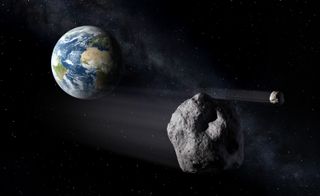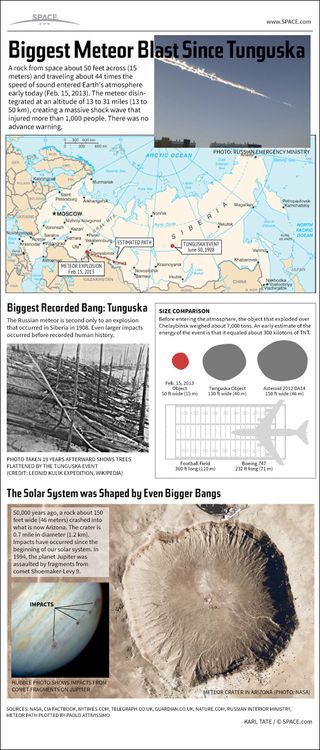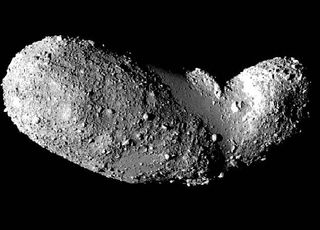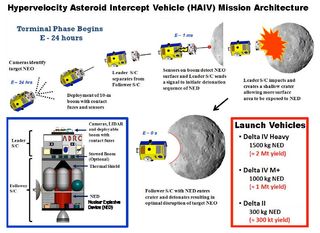
The most destructive weapon humanity has ever developed could help our species avoid going the way of the dinosaurs.
Pretty much any asteroid that poses a threat to Earth can be blasted out of the heavens using a nuclear bomb, even with warning times of a week or less, say a team of scientists who have been developing the idea.
"We have the solution, using our baseline concept, to be able to mitigate the asteroid-impact threat, with any range of warning," Bong Wie, of Iowa State University, said Feb. 6 at the 2014 NASA Innovative Advanced Concepts (NIAC) meeting at Stanford University. [Video: Nuclear Bomb Takes Out Asteroid]

A very real threat
Wie presented his team's latest findings nearly a year to the day after a previously undetected 65-foot-wide (20 meters) space rock detonated in the skies above the Russian city of Chelyabinsk, injuring 1,500 people.
He and many other researchers regard the Feb. 15, 2013 Russian meteor explosion— which took locals and scientists alike by surprise — as a wake-up call about the threat Earth faces from incoming space rocks.
"A couple of years ago, I had to use the dinosaur example to justify our research," he said, referring to the asteroid impact that wiped out the giant reptiles 65 million years ago. "Now, that's no more — we had this major event."
Get the Space.com Newsletter
Breaking space news, the latest updates on rocket launches, skywatching events and more!
It's just a matter of time before Earth gets hit again, Wie and other scientists stress — and the next strike may inflict far more damage.
In a perfect world, hazardous space rocks would be detected decades before their close encounters with Earth, giving humanity enough time to launch robotic "gravity tractors," which would nudge the asteroids off course by flying alongside them for long periods of time.
But our species needs a strategy to employ when a dangerous asteroid pops onto the radar with much less time to spare — less than a year, for example. And nuclear bombs are the best answer, Wie said.


Wie and his colleagues are developing a concept spacecraft called the Hypervelocity Asteroid Intercept Vehicle, or HAIV. They've gotten two rounds of NIAC funding for their work, one in 2011 and the other in 2012.
The HAIV would rendezvous with an asteroid in deep space, then send a kinetic impactor barreling into the object to blast out a crater. The nuclear bomb would follow one millisecond behind — perhaps attached via a long boom, or perhaps flying freely — and then detonate inside the hole, shattering the asteroid into millions of tiny pieces.
Excavating a crater for the bomb increases its destructive power by a factor of 20, Wie said.
Some of the resulting asteroid fragments may still impact Earth, depending on how far away from our planet the explosion occurred. But the effects are likely to be minimal, Wie said.
For example, a 1,000-foot-wide (300 m) asteroid can be neutralized far outside Earth's gravitational field with a warning time of just 30 days, according to Wie. Computer simulations suggest that less than 0.1 percent of the destroyed object's mass would eventually strike our planet.
"We would have a heavy meteor shower, or maybe 100 Chelyabinsk meteor events," Wie said. But doing nothing, he added, invites a single impact with 150,000 times the power of the bomb dropped on the Japanese city of Hiroshima during World War II.
A complete solution?
Wie and his team suggest that the HAIV concept be coupled with an asteroid-warning system, such as the Asteroid Terrestrial-impact Last Alert System (ATLAS), a survey effort being led by the University of Hawaii with $5 million in NASA funding.
When it's fully operational in 2015, ATLAS should be able to provide a one-day warning for asteroids 26 feet (8 m) wide, a one-week alert for space rocks measuring 148 feet (45 m) across and a three-week warning for 459-foot (140 m) asteroids.
That should provide plenty of time to launch an HAIV mission, which would likely cost about $500 million, Wie said.
"If our system is going to be built, tested, pre-deployed, ready to be launched at any time, then we solve the problem," he said.
Follow Mike Wall on Twitter @michaeldwall and Google+. Follow us @Spacedotcom, Facebook or Google+. Originally published on Space.com.
Join our Space Forums to keep talking space on the latest missions, night sky and more! And if you have a news tip, correction or comment, let us know at: community@space.com.

Michael Wall is a Senior Space Writer with Space.com and joined the team in 2010. He primarily covers exoplanets, spaceflight and military space, but has been known to dabble in the space art beat. His book about the search for alien life, "Out There," was published on Nov. 13, 2018. Before becoming a science writer, Michael worked as a herpetologist and wildlife biologist. He has a Ph.D. in evolutionary biology from the University of Sydney, Australia, a bachelor's degree from the University of Arizona, and a graduate certificate in science writing from the University of California, Santa Cruz. To find out what his latest project is, you can follow Michael on Twitter.
